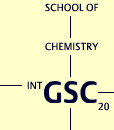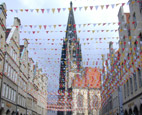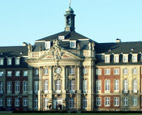| |
|

 |
|
||||||||||
 |
|
||||||||||||
| |
|||||||||||||
| |
|||||||||||||
| |
|
||||||||||||
| |
|
|
|
|
|
|
|
|
|
|
|
||
 |
|
||||||||||||
| |
|
|
|||||||||||
| |
|
|
|
|
|
||||||||
| |
|
||||||||||||
 

  |
|
||||||||||||
| Living
in Münster and the University of Münster
The city of Münster was awarded the LivCom Award 2004 as the most liveable community in category D (average daytime population 200,001 - 1,000,000).
Every year since 1997, The International Awards for Liveable Communities are given to cities in 5 categories with different population
numbers. The program Nations in Bloom is endorsed by the United Nations Environment Program for best practice in the
management of the local environment. Münster has won the gold medal in 2004 ahead of Coventry (GB) and Seattle (USA).
Other finalists in the same category were Bayamon (Puerto Rico), Changshu ( P.R. China), Newcastle upon Tyne (England),
Okayama (Japan), and Poznan (Poland).
(see LivCom homepage).
Formerly the capital of Westfalen, Münster is a modern
city with a population of about 280,000. As the economic heart of the
Münsterland, a region of 1.2 million inhabitants, the city commands
a position of considerable economic and social significance. Numerous
state and communal administrations are situated here, in addition to many
important wholesale and retail businesses. One of the main tourist attractions
of Münster is the “Prinzipalmarkt” (Main Market place)
including the historical Town Hall, where in 1648, the Treaty of Westfalia
which ended the 30 Years’ War was signed – an early document
of European unification. As a public university, the State of Northrhine-Westfalia
provides funds for operation, maintenance and building costs with assistance
from federal sources. While the teaching budget consists largely of state
funds, the research budget is comprised mainly from individual grants
(e.g. Deutsche Forschungsgemeinschaft, Ministerium für Schule, Wissenschaft
und Forschung des Landes Nordrhein-Westfalen, Deutscher Akademischer The University of Münster was founded in 1780 by Freiherr Franz von Fürstenberg. In 1805 it expanded to a Prussian State University for Westfalia with the Faculties of Law and Medicine. In 1843 its name changed to “Royal Academy of Theology and Arts”. In 1902 the academy was awarded the designation “Westfälische Wilhelms-Universität” by the Emperor Wilhelm II. Currently the University of Münster offers curricula in more than 100 different fields ranging from Archeology to Zoology. It is composed of 15 departments (Fachbereiche), including Theology, Law, Medicine, Economics, Humanities, Languages, Philosophy, Music, Biology, Chemistry and Pharmacy, Geosciences, Mathematics, Physics and Astronomy. Masters (Diplom) and doctoral degrees are offered in these areas. The first chemistry chair was established in 1856 (J. W. Hittorf) as part of the medical faculty. As an independent entity, the original chemistry institute was opened in 1879, and later replaced by the present premises of the Naturwissenschaftliches Zentrum, built during the period 1963–1966. Distinguished chemists who have worked in Münster include J. W. Hittorf (1824–1914), G. Domagk (1895– 1964), W. Klemm (1896–1987), F. Micheel (1900–1982), E. Wicke (1914–2000) and others. |
|
||||||||||||
| |
|||||||||||||
| |
|||||||||||||
| |
|||||||||||||
| |
|||||||||||||
| |
|||||||||||||
| |
|||||||||||||
| |
|||||||||||||
| |
|||||||||||||